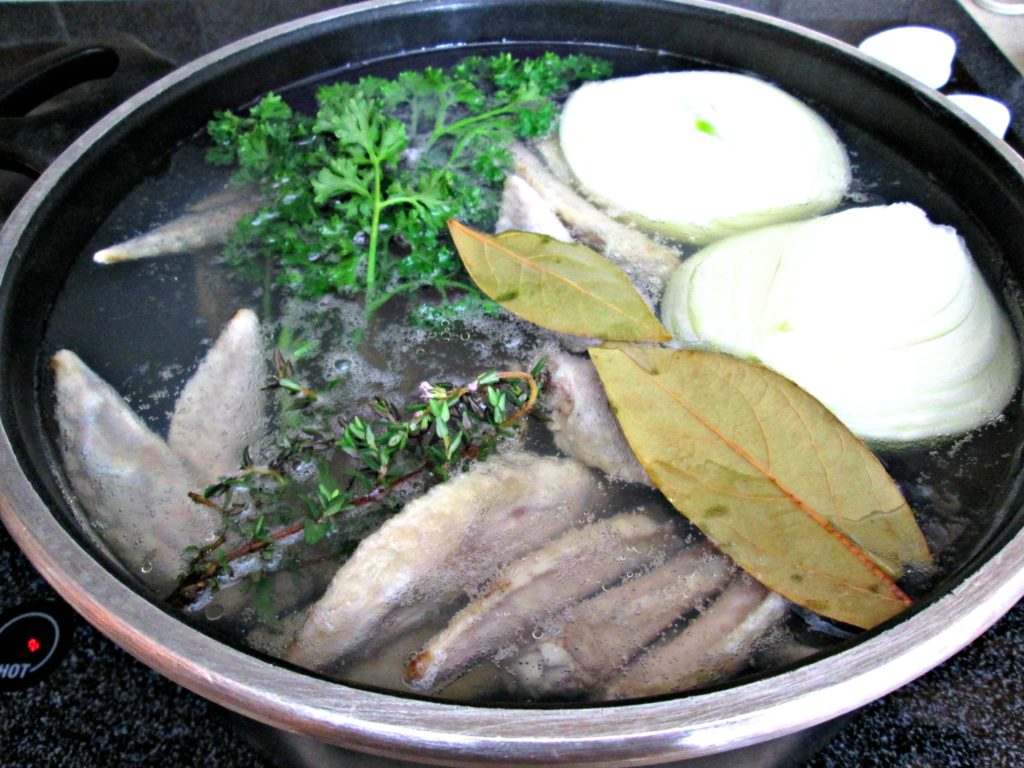Is Chicken Stock Broth?
Technically Chicken Stock and Broth aren’t the same thing, though, they basically have all of the same ingredients. Stock, however, is more concentrated and thicker because of the added bones and the cooked down gelatin secreted from them and Broth usually gets it’s flavor from adding meat instead. So to be clear, Stock is made using cooked bones, broth has no bones and is made by using the meat only, instead. Various herbs, seasonings and vegetables can be added to each to flavor them up but other than that there virtually isn’t any other difference. These recipes are usually cooked an average of 3 to 4 hours but some recipes claim they can be done in as little as 30 minutes and as crazy as 12. The truth is there is no absolute way of doing it as long as the desired effect is reached. My recipe is called a Chicken Stock Broth because I use the tips from chicken wings. This way the tips, most would throw in the trash, don’t go to waste. And, because there is such a small amount of bone in them, it gives a nice happy medium base, between a Stock and a Broth, with plenty of flavor for any recipe that calls for Stock or Broth.
Chicken Stock Bones
Most restaurants will use raw Chicken Carcass’s for their Chicken Stock. But, unless you’re carving up your own boneless breasts and chicken thighs, they’re a little hard to come by. Though Restaurants purchase these frozen, by the case, you most likely won’t be able to find them at your grocery store. Though, a good butcher shop should be able to sell them to you, a good alternative is the wings. Most recipes will suggest that to you but I say, “humbug!” Wings are spendy and cost a lot more per pound than breast meat or chicken legs and thighs. So save the wings for other recipes and just use the tips. Wing tips have enough bone, meat and skin on them to flavor up and color any good Stock. I personally just add them to a zip lock back and store them in the freezer until I need to make some.
Chicken Stock Herbs and Seasonings
A good Chicken Stock or Broth should have these basic ingredients; Onion, Parsley, Thyme, Bay Leaves and Garlic. You go well over and beyond these or even cut back to the minimum Onion but these are the good makings for a good soup base or any other recipe that calls for Stalk or Broth. The addition of vegetables will make it more hearty, so you end up with more of Vegetable/Chicken Broth; which is great because it adds more flavor. Carrots, Celery and Leak are most commonly used; even Tomatoes, at times. But if you want to add some heat you can throw in all kinds of different peppers and other spices. In Asian cooking, it’s real common to crush ginger root and add that right along with the onion.
I mentioned that a good stalk is generally cooked for several hours and because of this there tends to be a lot of reduction in the stock. But don’t hesitate to add more water and cook longer if you’re wanting or needing more Chicken Stock. The picture below is my stock at the earliest stage of the process with all of the basic ingredients added that I’ve included in the list below. Feel free to add anything else to this recipe.
Be sure to watch this short Chicken Stock Video tutorial below and I’ll show you just how easy this is to make your self. Also be sure to look into any of my Cajun Recipes if you’re celebrating the upcoming Mardi Gras Holiday season.
Chicken Stock Broth Ingredients:
3 qt Water, approximately
1 lbs Chicken Bones, raw
1 Onion, cut in half
1/2 bunch Parsley
2 sprigs Thyme
2 Bay Leaves
2 Garlic Cloves
Salt and Pepper to taste, optional
This Chicken Stock Broth can last 3 to 4 days in your refrigerator.

















